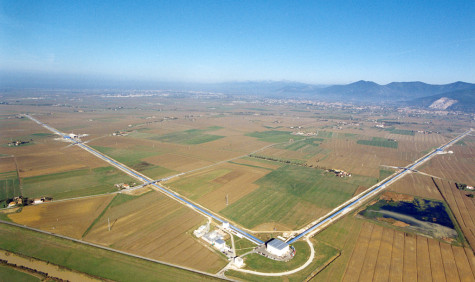Nobel Prize-winning research into gravitational waves using the Grid
The Nobel Prize in Physics 2017 was awarded to Rainer Weiss, Barry Barish and Kip Thorne of the LIGO-Virgo collaboration, for 'their decisive contributions to the LIGO detector and the detection of gravitational waves'. The research consortium makes use of SURF's Grid facility, among other things.
Albert Einstein's spacetime
The first ripples in spacetime, so-called gravitational waves, were measured by two US LIGO detectors in 2015 and 2016. These vibrations in the "backbone" of the universe provide a milestone in physics and astronomy. Albert Einstein suggested 100 years ago that the universe consisted of space and time. According to him, these formed one whole, which he called spacetime. During a big event, spacetime can vibrate, like the ripples in a pond when one throws a stone into it. Einstein's claim can only now be proven, with extremely sensitive detectors. In these, laser beams shoot through kilometre-long arms. When a gravitational wave passes by the earth, the beam shifts by a millionth of a millionth of a millionth of a metre.
Detector in Europe
Nobel laureates Rainer Weiss (emeritus professor of physics at MIT) and Kip Thorne (emeritus Richard P. Feynman professor of theoretical physics at Caltech) have been working on the Laser Interferometer Gravitational-wave Observatory LIGO since the 1980s. Together with Barry Barish (Linde Professor of Physics, emeritus of Caltech), they are at the heart of the LIGO project. On 14 August 2017, the latest gravitational waves were measured. This was also done for the first time by a dedicated detector in Europe, the Advanced Virgo near Pisa, Italy, which joined the LIGO detectors from 1 August 2017.
Dutch scientists
A large number of Dutch scientists were closely involved in these spectacular discoveries and also play an important role in further research into gravitational waves. For instance, physicists from Nikhef - the National Institute for Subatomic Physics - made important contributions to the instrumentation and data analysis of this research. Furthermore, Nikhef plays an important role in the Einstein Telescope project, a future observatory for gravitational waves.
12.5 million hours of computation
Gravitational wave research requires a lot of computing power. The LIGO-Virgo Collaboration makes use of the Dutch National e-Infrastructure, coordinated by SURF, for this purpose. At the Dutch Grid facilities alone, LIGO-Virgo will perform 12.5 million hours of computational work in 2017.
About LIGO and Virgo
LIGO is funded by the US National Science Foundation and run by Caltech and MIT, which designed and built the project. More than 1,000 scientists from around the world participate in it through the LIGO Scientific Collaboration.
The Virgo Collaboration consists of more than 280 physicists and engineers from 20 different European research groups at the Centre National de la Recherche Scientifique (CNRS) in France, the Istituto Nazionale di Fisica Nucleare in Italy, Nikhef in the Netherlands, MTA Wigner RCP in Hungary, the POLGRAW group in Poland, the Universitat de València in Spain, and the European Gravitational Observatory, the laboratory where the Virgo detector is housed near Pisa in Italy.
